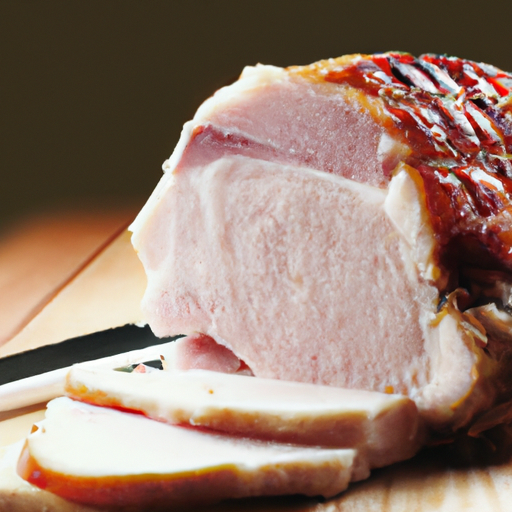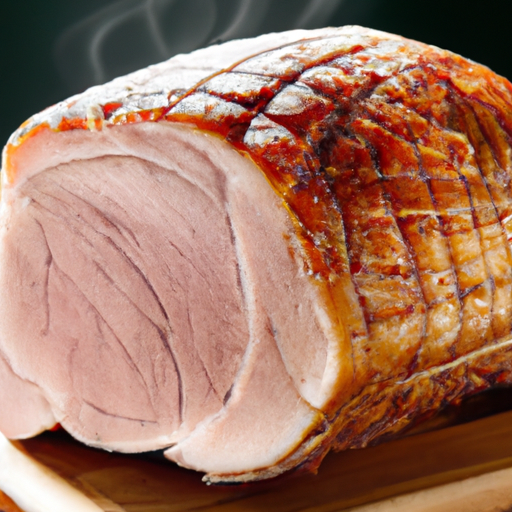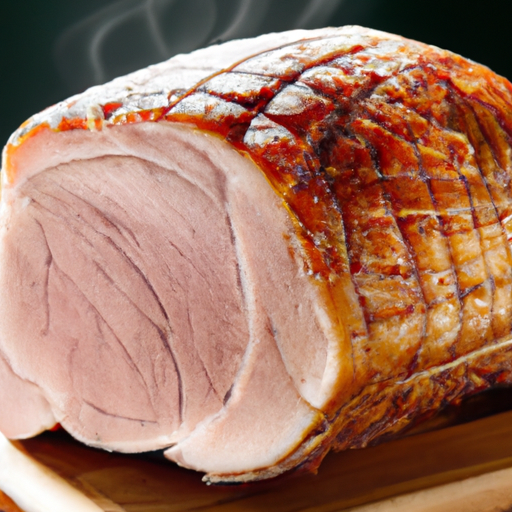Are you tired of struggling to cook the perfect loin of pork? Look no further! Introducing the “Perfectly Cooked Loin of Pork” – a kitchen must-have that takes the guesswork out of cooking times. With this innovative product, you can now enjoy succulent and tender pork every time. Whether you’re a seasoned chef or a cooking novice, this product is designed to simplify your culinary experience and deliver outstanding results. Say goodbye to undercooked or overcooked pork and say hello to perfectly cooked, melt-in-your-mouth goodness.

Choosing the Right Cut of Loin of Pork
When it comes to cooking a succulent and flavorful loin of pork, choosing the right cut is key. The loin of pork offers a variety of cuts, each with its own unique texture and flavor. So, before you start planning your recipe, it’s important to understand the different cuts available and select the one that suits your needs.
The Different Cuts of Loin of Pork
-
Pork Tenderloin: This is the most tender and leanest cut of the loin. It’s perfect for those who prefer a leaner option, as it contains very little fat. Pork tenderloin is typically small in size, making it suitable for quick cooking methods like grilling or pan-searing.
-
Pork Loin Center-Cut: Often referred to as the “center-cut roast,” this cut is taken from the center of the loin. It’s slightly fattier than the tenderloin but still lean overall. The center-cut roast is a versatile cut that can be roasted, grilled, or pan-seared to perfection.
-
Pork Loin Chop: These are bone-in slices taken from the loin. Pork loin chops are known for their juicy and flavorful meat. The bone adds extra flavor to the meat during cooking, making it a popular choice for grilling or pan-searing.
-
Pork Loin Rib-End Roast: This cut is taken from the rib end of the loin and is known for its marbling and tenderness. It’s a fattier cut compared to the other loin cuts, which means it delivers an incredible amount of flavor when roasted or slow-cooked.
Selecting the Best Cut for Your Recipe
To choose the best cut of loin of pork for your recipe, consider the cooking method and flavors you want to achieve. If you’re looking for a lean and tender option, go for pork tenderloin or center-cut roast. For maximum juiciness and flavor, opt for pork loin chops or rib-end roast. By selecting the right cut, you can ensure the success of your pork dish.
Preparation and Seasoning
Preparing the loin of pork before cooking is essential to enhance its flavor and tenderness. Here are some key steps to take when preparing and seasoning your loin of pork.
Trimming Excess Fat
Before cooking, it’s important to trim any excess fat from the loin of pork. While fat can add flavor, too much can make the meat greasy. Use a sharp knife to carefully trim the visible fat, leaving a thin layer for moisture and flavor.
Brining for Moisture and Flavor
If you’re aiming for a moist and flavorful loin of pork, consider brining it before cooking. Brining involves soaking the meat in a solution of water, salt, and other seasonings for a period of time. This process enhances the meat’s moisture retention, resulting in a juicier and tastier final dish.
To prepare a brine, dissolve salt and your choice of seasonings in water. Submerge the pork loin in the brine and refrigerate for several hours or overnight. Remember to rinse the brine off the meat before cooking.
Seasoning Options and Recommendations
When it comes to seasoning a loin of pork, there are numerous options to choose from. Some popular choices include basic salt and pepper, garlic powder, paprika, and herbs like rosemary or thyme. The key is to select seasonings that complement the natural flavors of the pork without overpowering them.
For a simple yet delicious seasoning, try rubbing a mixture of salt, pepper, and garlic powder onto the surface of the pork loin. If you’re feeling adventurous, experiment with different spice blends or marinades to add an extra layer of flavor.
Marinating Options
Marinating the loin of pork is another great way to infuse it with flavor. A marinade is a seasoned liquid mixture that the meat soaks in before cooking. It helps to tenderize the meat and adds depth to its taste. Here are some considerations for choosing the right marinade and marinating techniques.
Choosing a Marinade
When selecting a marinade for your loin of pork, the options are virtually endless. You can choose from a wide range of flavors, such as Asian-inspired soy-ginger marinade, citrus-based marinade with lemon and herbs, or even a sweet and tangy barbecue marinade.
Consider the flavors you want to bring out in the pork and choose a marinade that complements your chosen cut. The marinade should ideally contain some acidity, like citrus juice or vinegar, to help tenderize the meat. You can also experiment with adding different herbs and spices to tailor the marinade to your taste.
Marinating Time and Techniques
The marinating time for a loin of pork will depend on its size and the chosen cut. As a general rule, marinate the pork for at least 30 minutes for smaller cuts and up to 24 hours for larger cuts. However, it’s essential not to marinate the meat for too long, as the acid in the marinade can break down the meat’s proteins, resulting in an undesirable texture.
To marinate the pork, place it in a shallow dish or a resealable plastic bag. Pour the marinade over the meat, ensuring that it’s fully coated. If using a plastic bag, remove as much air as possible before sealing. Allow the pork to marinate in the refrigerator, turning occasionally to ensure even distribution of flavors.

Cooking Methods
Once your loin of pork is properly prepared and seasoned, it’s time to start cooking. The cooking method you choose will depend on the cut of pork and your personal preference. Here are three popular cooking methods to consider.
Roasting in the Oven
Oven-roasting is a classic method that yields a tender and flavorful loin of pork. Preheat your oven to the recommended temperature and place the pork on a wire rack set in a roasting pan. This allows the heat to circulate evenly around the meat, ensuring even cooking.
Cooking times will vary depending on the cut and size of the pork loin, so refer to a reliable recipe or cooking chart for specific guidelines. Avoid overcooking, as it can result in dry and tough meat. Use a meat thermometer to check for doneness, and remember to let the meat rest before slicing.
Grilling on the BBQ
Grilling the loin of pork on a barbecue is an excellent way to infuse it with a smoky flavor and achieve those beautiful grill marks. Preheat the grill to medium-high heat and oil the grates to prevent sticking.
Place the pork on the grill and cook with the lid closed, turning occasionally to ensure even cooking. Again, refer to a cooking chart or recipe for specific cooking times based on the cut and thickness of the pork loin. Use a meat thermometer to check for the desired internal temperature.
Pan-Searing on the Stovetop
Pan-searing is a quick and easy cooking method for smaller cuts like tenderloins or pork chops. Heat a skillet or frying pan over medium-high heat and add a small amount of oil or butter. Once the pan is hot, carefully place the pork into the pan.
Cook the pork on each side until it develops a golden-brown crust and reaches the desired internal temperature. This method provides a delicious caramelization on the surface of the meat while keeping the interior moist and tender.
Temperature and Cooking Times
Achieving the perfect internal temperature is essential when cooking a loin of pork to ensure both safety and optimal tenderness. Here are some guidelines to help you gauge the internal temperature and determine cooking times.
Internal Temperature Guidelines
The safe internal temperature for cooked pork is 145°F (63°C) as recommended by the USDA. However, the pork will continue to cook and rise in temperature as it rests, so it’s advised to remove it from the heat when it reaches around 140°F (60°C).
To measure the internal temperature, insert a meat thermometer into the thickest part of the pork loin, avoiding any bone. Let the thermometer sit for a few seconds until the reading stabilizes. Remember to clean the thermometer between readings to avoid cross-contamination.
Factors Affecting Cooking Times
Several factors can affect the cooking time of a loin of pork. The thickness and size of the cut, as well as the starting temperature of the meat, all play a role. Additionally, cooking at high altitudes or using different cooking methods may require adjustments to cooking times.
It’s always best to rely on a meat thermometer for accuracy rather than solely relying on cooking times. This ensures the pork is cooked to the right internal temperature, resulting in tender and juicy meat.
Resting the Meat
Resting the cooked loin of pork may seem like an unnecessary step, but it’s actually crucial for a more enjoyable dining experience. Here’s why resting is important and some recommendations for resting times.
Why Resting is Important
Resting the meat allows the juices to redistribute throughout the pork loin. When the meat is exposed to heat during cooking, the juices move towards the center. If you slice the pork immediately after cooking, the juices will flow out onto the cutting board instead of staying inside the meat.
By allowing the meat to rest, you ensure that the moisture remains locked within each slice, resulting in a juicier and more flavorful pork loin.
Resting Time Recommendations
For a loin of pork, it’s generally recommended to let it rest for at least 5 to 10 minutes after cooking. This resting period allows the meat to relax and the juices to redistribute. Larger cuts may require a slightly longer resting time, up to 20 minutes to ensure optimal tenderness.
To keep the meat warm while resting, loosely cover it with aluminum foil. This will help retain the heat without trapping too much steam, which could affect the texture of the pork.
Serving Suggestions
Now that your perfectly cooked and rested loin of pork is ready, it’s time to think about how to serve it. Here are some serving suggestions, accompaniments, and tips for presenting your pork dish.
Accompaniments and Side Dishes
A loin of pork pairs well with a variety of side dishes and accompaniments. Here are some classic choices to consider:
- Roasted Vegetables: Seasonal vegetables like carrots, Brussels sprouts, or sweet potatoes roasted alongside the pork make for a flavorful and vibrant side dish.
- Mashed Potatoes: Creamy mashed potatoes complement the richness of the pork and soak up any delicious pan drippings.
- Applesauce: The combination of tender pork and sweet applesauce is a classic pairing that never disappoints.
- Gravy: A savory gravy made from the pan drippings adds an extra layer of flavor to the pork and any side dishes you serve.
Feel free to explore various flavors and experiment with your favorite sides. The goal is to create a well-balanced meal that enhances the flavors of the pork while adding variety to your plate.
Garnishing and Presentation Tips
To elevate the visual appeal of your cooked pork loin, consider these garnishing and presentation tips:
- Fresh Herbs: Sprinkle some freshly chopped herbs, such as parsley or chives, over the pork before serving for a pop of color and freshness.
- Citrus Zest: Grate some lemon or orange zest over the plated pork to add a burst of citrus aroma and flavor.
- Sliced Fruit: Arrange some thinly sliced fruit, like oranges or apples, around the pork loin for an elegant and refreshing touch.
- Sauce Drizzle: Drizzle a complementary sauce, such as a balsamic reduction or chimichurri, over the pork for an added layer of flavor and a visually appealing presentation.
Remember that presentation is just as important as taste when it comes to culinary experiences. Taking the time to garnish your dish will impress your guests and make the meal more visually appealing.
Leftover Ideas and Storage
If you find yourself with leftover loin of pork, don’t fret! There are plenty of creative ways to utilize the remaining meat and ensure nothing goes to waste.
Creative Recipes with Leftover Loin of Pork
- Pork Tacos: Shred the leftover pork and create delicious tacos. Serve with your favorite toppings like guacamole, salsa, and shredded cheese.
- Pork Fried Rice: Chop the leftover pork into small pieces and incorporate it into a flavorful fried rice dish. Add vegetables, scrambled eggs, and soy sauce for a satisfying meal.
- Pork Sandwiches: Slice the pork loin and make hearty sandwiches with fresh bread, lettuce, tomato, and your choice of condiments. Consider adding a tangy slaw or pickles for added crunch and flavor.
These are just a few examples, so let your creativity shine and invent your own signature dishes with leftover loin of pork.
Proper Storage and Shelf Life
To maximize the shelf life of leftovers, store the cooked pork loin in an airtight container or wrap it tightly in aluminum foil or plastic wrap. Properly stored, it can be refrigerated for up to 3 to 4 days.
Additionally, consider freezing any excess cooked pork for later use. Wrap it tightly in freezer-safe packaging and label it with the date. Frozen cooked pork can be safely stored for up to 2 to 3 months. When ready to use, thaw it in the refrigerator overnight before reheating or incorporating it into your favorite recipes.
Common Mistakes to Avoid
To ensure that your loin of pork turns out perfectly every time, be aware of these common mistakes and avoid them:
Overcooking the Loin of Pork
Overcooking can result in dry, chewy meat that lacks flavor. It’s important to monitor the internal temperature of the pork and remove it from the heat when it reaches the desired level of doneness. Remember, the meat will continue to cook as it rests, so removing it slightly before reaching the target temperature is advisable.
Using Improper Seasonings
Choosing the right seasoning is crucial to enhancing the flavor of the pork loin. Avoid overpowering the meat with excessive seasoning or using incompatible flavor profiles. Stick to simple yet complementary seasonings that allow the natural taste of the pork to shine through.
Taking the Meat Out of the Oven Too Early
When roasting a loin of pork, it’s important to resist the temptation to take it out of the oven too early. Removing the meat prematurely can result in it being undercooked, leading to a potentially unsafe dish. It’s recommended to use a meat thermometer to accurately determine when the pork is cooked to the proper internal temperature.
Frequently Asked Questions (FAQs)
How long does it take to cook a loin of pork?
The cooking time for a loin of pork will vary depending on the size and cut. As a general guideline, you can estimate approximately 20 minutes per pound at the recommended temperature. However, it’s always best to use a meat thermometer to ensure the pork reaches the correct internal temperature.
Can I use a slow cooker for cooking the pork loin?
Yes, a slow cooker can be a fantastic tool for cooking a loin of pork. Slow cooking allows the meat to become tender and develop rich flavors. Follow a reliable recipe for specific instructions on heat settings and cooking times. Remember, slow cooking may require longer cooking times compared to other methods, so plan accordingly.
In conclusion, selecting the right cut of loin of pork, properly preparing and seasoning the meat, choosing the appropriate cooking method, and understanding the importance of resting all play vital roles in achieving a perfectly cooked and flavorful dish. By following these tips and guidelines, you’ll be well on your way to impressing your family and friends with a delicious and succulent loin of pork.
